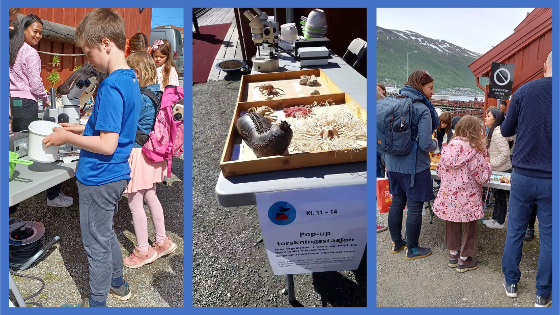
Big success with pop-up research station at seafood festival
Fromm lab members participate in successful outreach event.
The seafood festival (‘Sjømatfesten’) which was held this year on 7-11th of June 2022 is a week long annual event. UiT – The Norwegian Arctic University is one of the collaborators of the event and has a tradition of hosting engaging activities on the occasion. Traditionally, the Arctic University Museum and Polar Museum (a part of the University Museum), arrange activities in multiple places across the city which attract a lot of visitors and are a great outreach opportunity with the public.
This year, as the Fromm lab's host institution, The Arctic University Museum celebrates its 150th anniversary, lab members and PhD students Anju and Vanessa participated at a pop-up research station in front of the Polar Museum. The set-up had a life on the beach (‘Liv i fjæra’) counter where children could bring their own catch from the shore and view it under the microscope while we tried to identify it. We also had which animals are closest relatives? (‘Hvilke dyr er nærmest slekt?’) counter with models of different marine animal groups like crustaceans and echinoderms where the participants had to guess the related animals to find the odd one out and justify their reasons. The bird beak (‘Fuglenebb’) counter had interactive games including models of food and beaks of different birds which the children would match to the birds.

PhD students Anju (left) and Vanessa (right) at their stations.
The event was a huge success and received very positive feedback from young and adults alike. It was an excellent opportunity to engange with school-kids on topics that are close to our research line of animal evolution and complexity and it ended with a record of 500 visitors from all age groups.
The outreach station was planned and set up by Karen Marie Christensen, the communication manager of the Arctic University Museum Tromsø and Vanessa Paynter, Anju Hembrom and Joel Wernström who are PhD students in the scientific collecion-based taxonomy and biosystemamtics section at the museum.